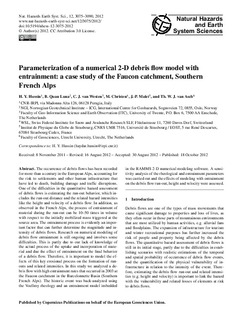| dc.contributor.author | Hussin, H.Y. | |
| dc.contributor.author | Quan, Luna Byron | |
| dc.contributor.author | Westen, C. J. van | |
| dc.contributor.author | Christen, M. | |
| dc.contributor.author | Malet, J.P. | |
| dc.contributor.author | Asch, Th. W. J. van | |
| dc.date.accessioned | 2016-01-27T15:18:26Z | |
| dc.date.accessioned | 2016-01-29T12:14:12Z | |
| dc.date.available | 2016-01-27T15:18:26Z | |
| dc.date.available | 2016-01-29T12:14:12Z | |
| dc.date.issued | 2012 | |
| dc.identifier.citation | Natural hazards and earth system sciences 2012, 12:3075-3090 | |
| dc.identifier.issn | 1684-9981 | |
| dc.identifier.uri | http://hdl.handle.net/11250/2375299 | |
| dc.description | - | |
| dc.description.abstract | The occurrence of debris flows has been recorded for more than a century in the European Alps, accounting for the risk to settlements and other human infrastructure that have led to death, building damage and traffic disruptions. One of the difficulties in the quantitative hazard assessment of debris flows is estimating the run-out behavior, which includes the run-out distance and the related hazard intensities like the height and velocity of a debris flow. In addition, as observed in the French Alps, the process of entrainment of material during the run-out can be 10–50 times in volume with respect to the initially mobilized mass triggered at the source area. The entrainment process is evidently an important factor that can further determine the magnitude and intensity of debris flows. Research on numerical modeling of debris flow entrainment is still ongoing and involves some difficulties. This is partly due to our lack of knowledge of the actual process of the uptake and incorporation of material and due the effect of entrainment on the final behavior of a debris flow. Therefore, it is important to model the effects of this key erosional process on the formation of run-outs and related intensities. In this study we analyzed a debris flow with high entrainment rates that occurred in 2003 at the Faucon catchment in the Barcelonnette Basin (Southern French Alps). The historic event was back-analyzed using the Voellmy rheology and an entrainment model imbedded in the RAMMS 2-D numerical modeling software. A sensitivity analysis of the rheological and entrainment parameters was carried out and the effects of modeling with entrainment on the debris flow run-out, height and velocity were assessed. | |
| dc.language.iso | eng | |
| dc.title | Parameterization of a numerical 2-D debris flow model with entrainment: a case study of the Faucon catchment, Southern French Alps | |
| dc.type | Journal article | |
| dc.date.updated | 2016-01-27T15:18:26Z | |
| dc.identifier.doi | 10.5194/nhess-12-3075-2012 | |
| dc.identifier.cristin | 997752 | |
